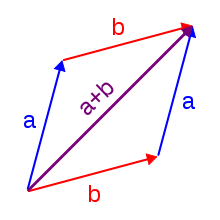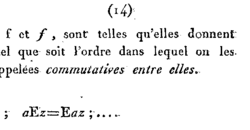Commutative property
 | |
| Type | Property |
|---|---|
| Field | Algebra |
| Statement | A binary operation is commutative if changing the order of the operands does not change the result. |
| Symbolic statement | |
In mathematics, a binary operation is commutative if changing the order of the operands does not change the result. It is a fundamental property of many binary operations, and many mathematical proofs depend on it. Perhaps most familiar as a property of arithmetic, e.g. "3 + 4 = 4 + 3" or "2 × 5 = 5 × 2", the property can also be used in more advanced settings. The name is needed because there are operations, such as division and subtraction, that do not have it (for example, "3 − 5 ≠ 5 − 3"); such operations are not commutative, and so are referred to as noncommutative operations. The idea that simple operations, such as the multiplication and addition of numbers, are commutative was for many years implicitly assumed. Thus, this property was not named until the 19th century, when mathematics started to become formalized.[1][2] A similar property exists for binary relations; a binary relation is said to be symmetric if the relation applies regardless of the order of its operands; for example, equality is symmetric as two equal mathematical objects are equal regardless of their order.[3]
Mathematical definitions[edit]
A binary operation on a set S is called commutative if[4][5]
One says that x commutes with y or that x and y commute under if
Examples[edit]

Commutative operations[edit]

- Addition and multiplication are commutative in most number systems, and, in particular, between natural numbers, integers, rational numbers, real numbers and complex numbers. This is also true in every field.
- Addition is commutative in every vector space and in every algebra.
- Union and intersection are commutative operations on sets.
- "And" and "or" are commutative logical operations.
Noncommutative operations[edit]
Some noncommutative binary operations:[6]
Division, subtraction, and exponentiation[edit]
Division is noncommutative, since .
Subtraction is noncommutative, since . However it is classified more precisely as anti-commutative, since .
Exponentiation is noncommutative, since . This property leads to two different "inverse" operations of exponentiation (namely, the nth-root operation and the logarithm operation), which is unlike the multiplication. [7]
Truth functions[edit]
Some truth functions are noncommutative, since the truth tables for the functions are different when one changes the order of the operands. For example, the truth tables for (A ⇒ B) = (¬A ∨ B) and (B ⇒ A) = (A ∨ ¬B) are
A B A ⇒ B B ⇒ A F F T T F T T F T F F T T T T T
Function composition of linear functions[edit]
Function composition of linear functions from the real numbers to the real numbers is almost always noncommutative. For example, let and . Then
Matrix multiplication[edit]
Matrix multiplication of square matrices is almost always noncommutative, for example:
Vector product[edit]
The vector product (or cross product) of two vectors in three dimensions is anti-commutative; i.e., b × a = −(a × b).
History and etymology[edit]

Records of the implicit use of the commutative property go back to ancient times. The Egyptians used the commutative property of multiplication to simplify computing products.[8][9] Euclid is known to have assumed the commutative property of multiplication in his book Elements.[10] Formal uses of the commutative property arose in the late 18th and early 19th centuries, when mathematicians began to work on a theory of functions. Today the commutative property is a well-known and basic property used in most branches of mathematics.
The first recorded use of the term commutative was in a memoir by François Servois in 1814,[1][11] which used the word commutatives when describing functions that have what is now called the commutative property. Commutative is the feminine form of the French adjective commutatif, which is derived from the French noun commutation and the French verb commuter, meaning "to exchange" or "to switch", a cognate of to commute. The term then appeared in English in 1838.[2] in Duncan Gregory's article entitled "On the real nature of symbolical algebra" published in 1840 in the Transactions of the Royal Society of Edinburgh.[12]
Propositional logic[edit]
Rule of replacement[edit]
In truth-functional propositional logic, commutation,[13][14] or commutativity[15] refer to two valid rules of replacement. The rules allow one to transpose propositional variables within logical expressions in logical proofs. The rules are:
Truth functional connectives[edit]
Commutativity is a property of some logical connectives of truth functional propositional logic. The following logical equivalences demonstrate that commutativity is a property of particular connectives. The following are truth-functional tautologies.
- Commutativity of conjunction
- Commutativity of disjunction
- Commutativity of implication (also called the law of permutation)
- Commutativity of equivalence (also called the complete commutative law of equivalence)
Set theory[edit]
In group and set theory, many algebraic structures are called commutative when certain operands satisfy the commutative property. In higher branches of mathematics, such as analysis and linear algebra the commutativity of well-known operations (such as addition and multiplication on real and complex numbers) is often used (or implicitly assumed) in proofs.[16][17][18]
Mathematical structures and commutativity[edit]
- A commutative semigroup is a set endowed with a total, associative and commutative operation.
- If the operation additionally has an identity element, we have a commutative monoid
- An abelian group, or commutative group is a group whose group operation is commutative.[17]
- A commutative ring is a ring whose multiplication is commutative. (Addition in a ring is always commutative.)[19]
- In a field both addition and multiplication are commutative.[20]
Related properties[edit]
Associativity[edit]
The associative property is closely related to the commutative property. The associative property of an expression containing two or more occurrences of the same operator states that the order operations are performed in does not affect the final result, as long as the order of terms does not change. In contrast, the commutative property states that the order of the terms does not affect the final result.
Most commutative operations encountered in practice are also associative. However, commutativity does not imply associativity. A counterexample is the function
Distributive[edit]
Symmetry[edit]

Some forms of symmetry can be directly linked to commutativity. When a commutative operation is written as a binary function then this function is called a symmetric function, and its graph in three-dimensional space is symmetric across the plane . For example, if the function f is defined as then is a symmetric function.
For relations, a symmetric relation is analogous to a commutative operation, in that if a relation R is symmetric, then .
Non-commuting operators in quantum mechanics[edit]
In quantum mechanics as formulated by Schrödinger, physical variables are represented by linear operators such as (meaning multiply by ), and . These two operators do not commute as may be seen by considering the effect of their compositions and (also called products of operators) on a one-dimensional wave function :
According to the uncertainty principle of Heisenberg, if the two operators representing a pair of variables do not commute, then that pair of variables are mutually complementary, which means they cannot be simultaneously measured or known precisely. For example, the position and the linear momentum in the -direction of a particle are represented by the operators and , respectively (where is the reduced Planck constant). This is the same example except for the constant , so again the operators do not commute and the physical meaning is that the position and linear momentum in a given direction are complementary.
See also[edit]
- Anticommutative property
- Centralizer and normalizer (also called a commutant)
- Commutative diagram
- Commutative (neurophysiology)
- Commutator
- Parallelogram law
- Particle statistics (for commutativity in physics)
- Proof that Peano's axioms imply the commutativity of the addition of natural numbers
- Quasi-commutative property
- Trace monoid
- Commuting probability
Notes[edit]
- ^ Jump up to: a b Cabillón & Miller, Commutative and Distributive
- ^ Jump up to: a b Flood, Raymond; Rice, Adrian; Wilson, Robin, eds. (2011). Mathematics in Victorian Britain. Oxford University Press. p. 4. ISBN 9780191627941.
- ^ Weisstein, Eric W. "Symmetric Relation". MathWorld.
- ^ Krowne, p. 1
- ^ Weisstein, Commute, p. 1
- ^ Yark, p. 1
- ^ "User MathematicalOrchid". Mathematics Stack Exchange. Retrieved 20 January 2024.
- ^ Lumpkin 1997, p. 11
- ^ Gay & Shute 1987
- ^ O'Conner & Robertson Real Numbers
- ^ O'Conner & Robertson, Servois
- ^ Gregory, D. F. (1840). "On the real nature of symbolical algebra". Transactions of the Royal Society of Edinburgh. 14: 208–216.
- ^ Moore and Parker
- ^ Copi & Cohen 2005
- ^ Hurley & Watson 2016
- ^ Axler 1997, p. 2
- ^ Jump up to: a b Gallian 2006, p. 34
- ^ Gallian 2006, pp. 26, 87
- ^ Gallian 2006, p. 236
- ^ Gallian 2006, p. 250
References[edit]
Books[edit]
- Axler, Sheldon (1997). Linear Algebra Done Right, 2e. Springer. ISBN 0-387-98258-2.
- Abstract algebra theory. Covers commutativity in that context. Uses property throughout book.
- Copi, Irving M.; Cohen, Carl (2005). Introduction to Logic (12th ed.). Prentice Hall. ISBN 9780131898349.
- Gallian, Joseph (2006). Contemporary Abstract Algebra (6e ed.). Houghton Mifflin. ISBN 0-618-51471-6.
- Linear algebra theory. Explains commutativity in chapter 1, uses it throughout.
- Goodman, Frederick (2003). Algebra: Abstract and Concrete, Stressing Symmetry (2e ed.). Prentice Hall. ISBN 0-13-067342-0.
- Abstract algebra theory. Uses commutativity property throughout book.
- Hurley, Patrick J.; Watson, Lori (2016). A Concise Introduction to Logic (12th ed.). Cengage Learning. ISBN 978-1-337-51478-1.
Articles[edit]
- Lumpkin, B. (1997). "The Mathematical Legacy of Ancient Egypt – A Response To Robert Palter" (PDF) (Unpublished manuscript). Archived from the original (PDF) on 13 July 2007.
- Article describing the mathematical ability of ancient civilizations.
- Gay, Robins R.; Shute, Charles C. D. (1987). The Rhind Mathematical Papyrus: An Ancient Egyptian Text. British Museum. ISBN 0-7141-0944-4.
- Translation and interpretation of the Rhind Mathematical Papyrus.
Online resources[edit]
- "Commutativity", Encyclopedia of Mathematics, EMS Press, 2001 [1994]
- Krowne, Aaron, Commutative at PlanetMath., Accessed 8 August 2007.
- Definition of commutativity and examples of commutative operations
- Weisstein, Eric W. "Commute". MathWorld., Accessed 8 August 2007.
- Explanation of the term commute
- "Yark". Examples of non-commutative operations at PlanetMath., Accessed 8 August 2007
- Examples proving some noncommutative operations
- O'Conner, J.J.; Robertson, E.F. "History of real numbers". MacTutor. Retrieved 8 August 2007.
- Article giving the history of the real numbers
- Cabillón, Julio; Miller, Jeff. "Earliest Known Uses of Mathematical Terms". Retrieved 22 November 2008.
- Page covering the earliest uses of mathematical terms
- O'Conner, J.J.; Robertson, E.F. "biography of François Servois". MacTutor. Archived from the original on 2 September 2009. Retrieved 8 August 2007.
- Biography of Francois Servois, who first used the term






































